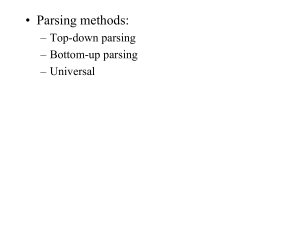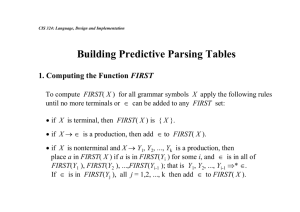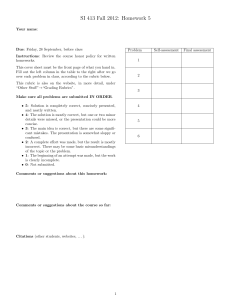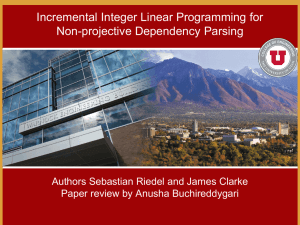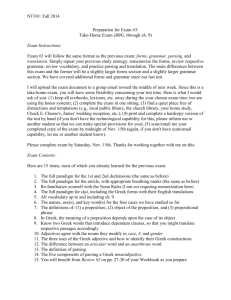COP4020 Programming Languages Computing LL(1) parsing table
advertisement
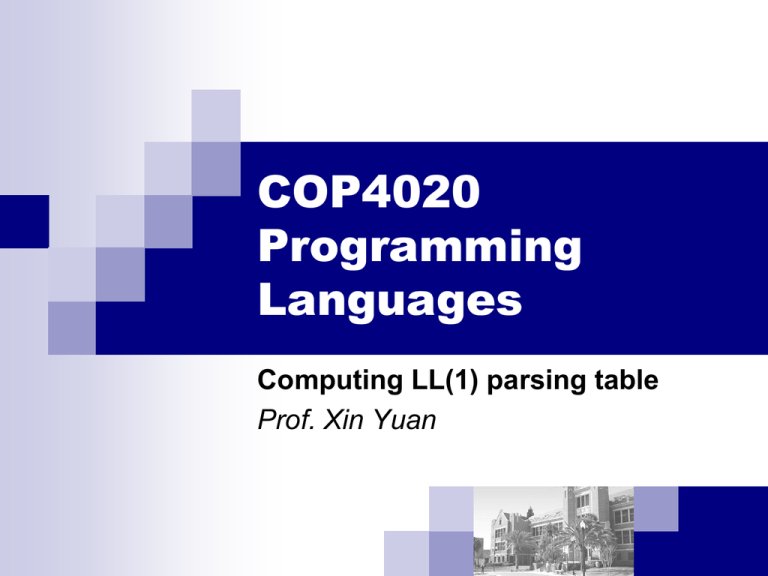
COP4020
Programming
Languages
Computing LL(1) parsing table
Prof. Xin Yuan
Overview
LL(1) parsing in action (Top-down parsing)
Computing LL(1) parsing table
5/29/2016
COP4020 Spring 2014
2
Using the parsing table, the predictive
parsing program works like this:
A stack of grammar symbols ($ on the
bottom)
A string of input tokens ($ at the end)
A parsing table, M[NT, T] of productions
Algorithm:
put ‘$ Start’ on the stack ($ is the end
of input string).
1) if top == input == $ then accept
2) if top == input then
pop top of the stack; advance to next
input symbol; goto 1;
3) if top is nonterminal
if M[top, input] is a production then
replace top with the production; goto 1
else error
4) else error
Example:
(1) E->TE’
(2) E’->+TE’
(3) E’->
(4) T->FT’
(5) T’->*FT’
(6) T’->
(7) F->(E)
(8) F->id
Stack
$E
$E’T
$E’T’F
$E’T’id
$E’T’
…...
E
E’
T
T’
F
id
(1)
+
*
(
(1)
(2)
(4)
input
id+id*id$
id+id*id$
id+id*id$
id+id*id$
+id*id$
$
(3)
(3)
(6)
(6)
(4)
(6)
(8)
)
(5)
(7)
production
E->TE’
T->FT’
F->id
This produces leftmost derivation:
E=>TE’=>FT’E’=>idT’E’=>….=>id+id*id
(1) E->TE’
(2) E’->+TE’
(3) E’->
(4) T->FT’
(5) T’->*FT’
(6) T’->
(7) F->(E)
(8) F->id
E
E’
T
T’
F
id
(1)
+
*
(
(1)
(2)
(4)
)
$
(3)
(3)
(6)
(6)
(4)
(6)
(5)
(8)
(7)
How to compute the parsing table for LL(1) grammar?
Key: We need to make choice for every production
When can E be expanded with production E->TE’?
Intuitively, any token that can be the first token by expanding TE’.
This should include all first token by expanding T, what are they?
What if T can derive empty string (
) , we should also include the first
token that can be derived from E’
What if E’ can also derive empty string? We should all possible tokens that
can potentially follow E?
When should E’ be expanded with production E’->
?
(1) E->TE’
(2) E’->+TE’
(3) E’->
(4) T->FT’
(5) T’->*FT’
(6) T’->
(7) F->(E)
(8) F->id
E
E’
T
T’
F
id
(1)
+
*
(
(1)
(2)
(4)
)
$
(3)
(3)
(6)
(6)
(4)
(6)
(5)
(8)
(7)
How to compute the parsing table for LL(1) grammar?
Intuition: We need to make choice for every production
•
•
•
•
Case 1 (easy): E’->+TE’: expand for all tokens that can be the first token
after expanding the right hand side of the production (expanding +TE’)
Case 1 (harder): E->TE’: expand for all tokens that can be the first token
after expanding TE’
We call this First set.
Case 2: E’->
: no first token?
Whenever we see a token that can potential follow E’ in a sentential form.
(Follow set)
For a production that can derive a string of tokens,
find all possible first tokens.
A production N -> X Y Z should be expanded when the token
can be the first of X Y Z (after derivation): First(X Y Z).
For a production that can derive empty string, find all
possible tokens that can follow the nonterminal.
When should we expand with E’->
?
Anything token that can potentially follow E’: Follow(E’).
First set and follow set
First( ): Here, is a string of symbols. The set of
terminals that begin strings derived from a.
If a is empty string or generates empty string, then empty
string is in First( ).
Follow(A):
Here, A is a nonterminal symbol.
Follow(A) is the set of terminals that can
immediately follow A in a sentential form.
Example:
S->iEtS | iEtSeS|a
E->b
First(a) = ?, First(iEtS) = ?, First(S) = ?
Follow(E) = ? Follow(S) = ?
Compute FIRST(X)
If a is a terminal then FIRST(a) = {a} (Case 1)
If X-> , add to FIRST(X). (Case 2)
If X Y1 Y2 ... Yk and Y1 Y2 ... Yi 1 add every none in
FIRST( Yi ) to FIRST(X). If Y1 Y2 ... Yk , add to
FIRST(X). (Case 3)
FIRST( Y1 Y2 ... Yk ): similar to the third case.
E->TE’
E’->+TE’|
T->FT’
T’->*FT’ |
F->(E) | id
FIRST(E) = ?
FIRST(E’)= ?
FIRST(T) = ?
FIRST(T’) = ?
FIRST(F) = ?
Computing first set
E->TE’
E’->+TE’|
T->FT’
T’->*FT’ |
F->(E) | id
5/29/2016
FIRST(E) = {(, id}
FIRST(E’)={+, }
FIRST(T) = {(, id}
FIRST(T’) = {*, }
FIRST(F) = {(, id}
COP4020 Spring 2014
10
Compute Follow(A)
If S is the start symbol, add $ to Follow(S).
If A-> B , add First( )-{ } to Follow(B).
If A-> B or A-> B and => , add Follow(A) to Follow(B).
Note: you are looking at the right hand side of productions!!!
E->TE’
E’->+TE’|
T->FT’
T’->*FT’ |
F->(E) | id
First(E) = {(, id}, Follow(E)={), $}
First(E’)={+, e}, Follow(E’) = {), $}
First(T) = {(, id}, Follow(T) = {+, ), $}
First(T’) = {*, e}, Follow(T’) = {+, ), $}
First(F) = {(, id}, Follow(F) = {*, +, ), $}
How to construct the parsing table?
With first(a) and follow(A), we can build the
parsing table. For each production A-> :
Add A-> to M[A, t] for each t in First( ).
If First() contains empty string
Add A-> to M[A, t] for each t in Follow(A)
if $ is in Follow(A), add A-> to M[A, $]
Make each undefined entry of M error.
Construct parsing table for the following
grammar:
E->TE’
E’->+TE’|
T->FT’
T’->*FT’ |
F->(E) | id
First(E) = {(, id}, Follow(E)={), $}
First(E’)={+, e}, Follow(E’) = {), $}
First(T) = {(, id}, Follow(T) = {+, ), $}
First(T’) = {*, e}, Follow(T’) = {+, ), $}
First(F) = {(, id}, Follow(F) = {*, +, ), $}
LL(1) grammar:
A grammar whose parsing table has no multiply-defined
entries is a LL(1) grammar.
use one input symbol of lookahead at each step to make a parsing
decision.
No ambiguous or left-recursive grammar can be LL(1)
A grammar is LL(1) iff for each set of A productions, where
A 1 | 2 | ... | n The following conditions hold:
First ( i ) First ( j ) {}, when 1 i n and 1 j n and i j
if i , the n
(a) no, j e, when i j
(b) First( j ) Follow(A) {}, when i j.


